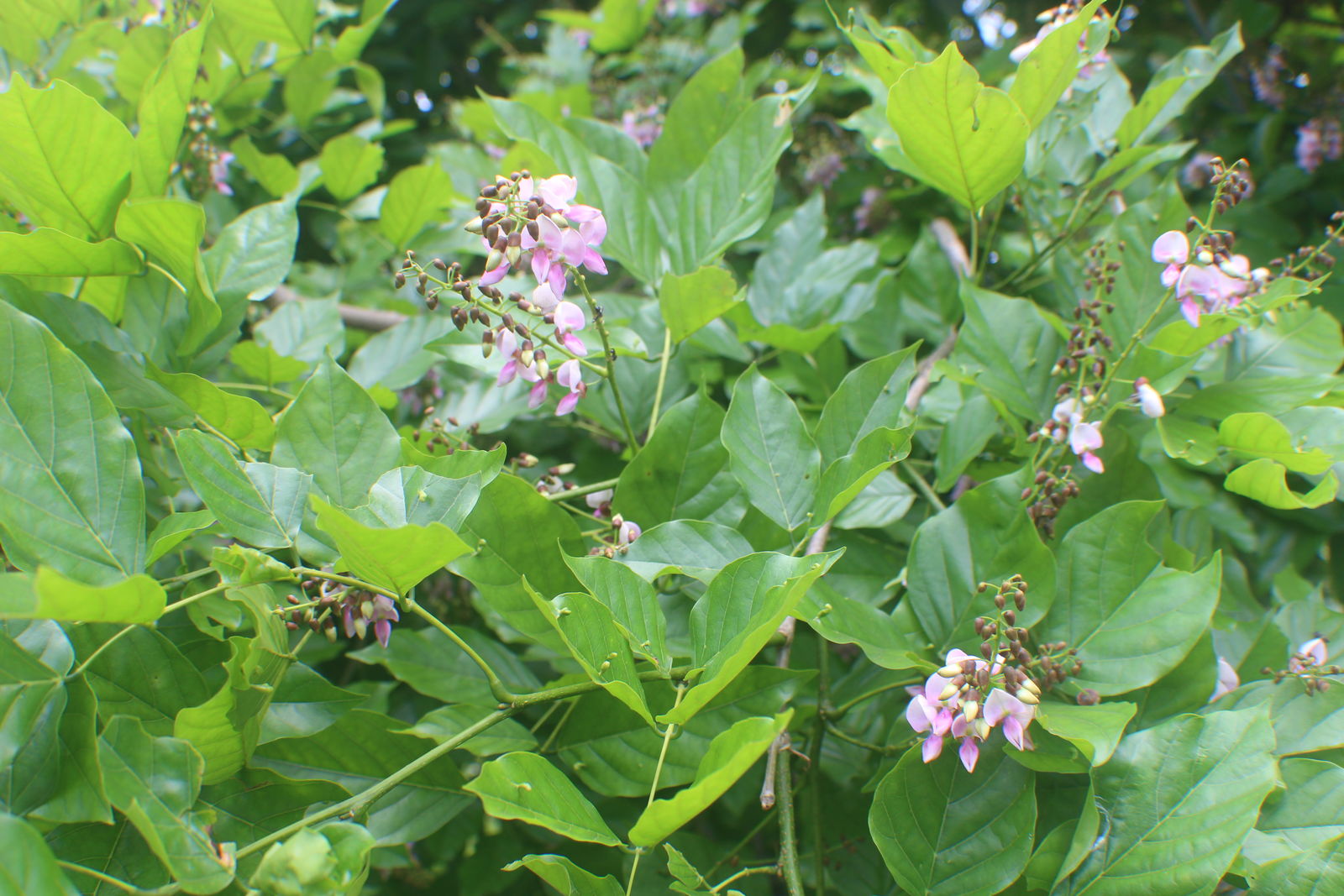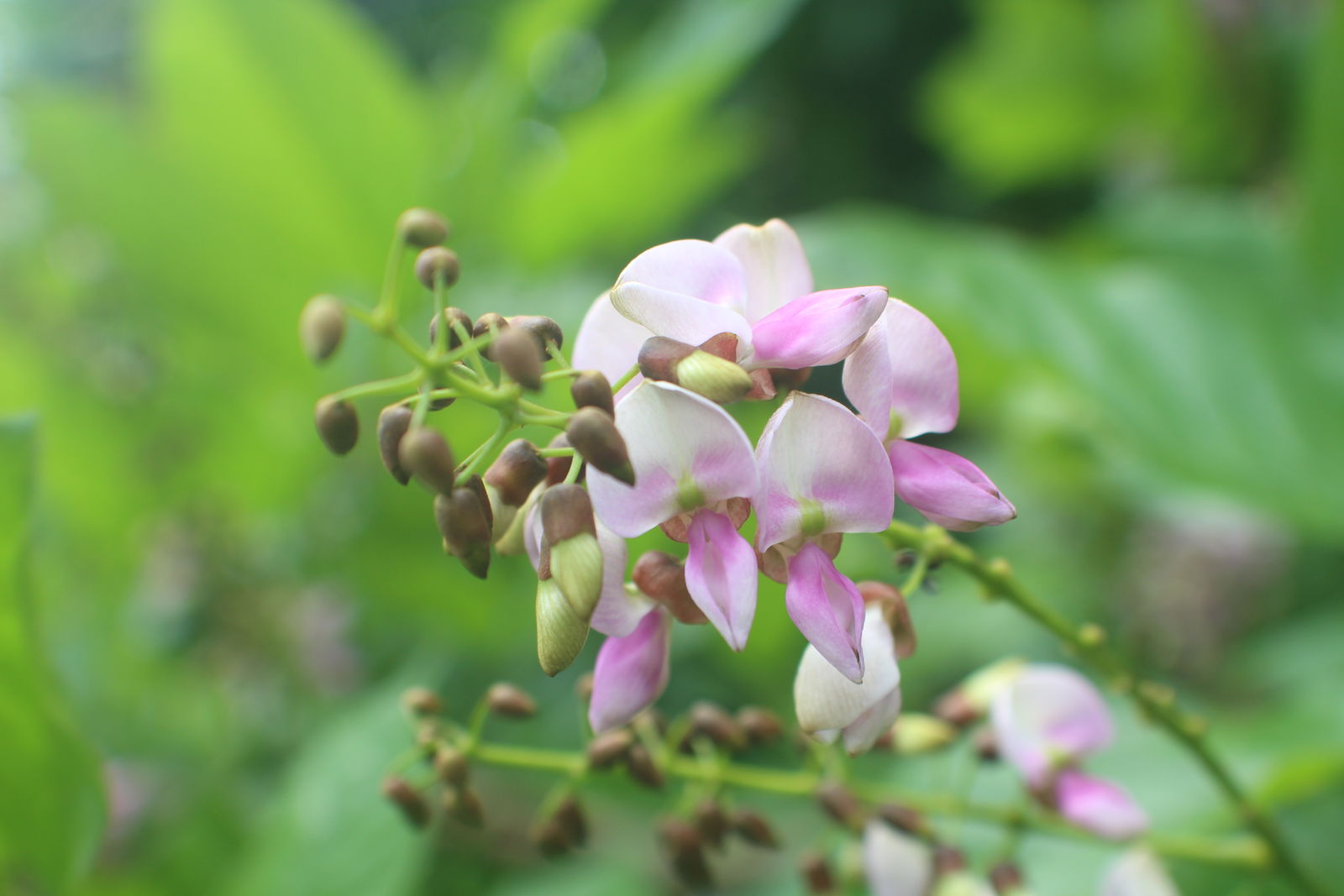Karanj
pongamia pinnata
Also known as: ["Indian beech","pongam bean tree","pongamia"]
Overview
A deciduous tree native to tropical and temperate Asia, valued for its oil-rich seeds and medicinal properties.
Benefits & Perks
["drought tolerant","shade tolerant","wildlife attractant (bees, butterflies, birds)"]
Botanical Classification
| Phylum: | Magnoliophyta |
| Class: | Magnoliopsida |
| Order: | Fabales |
| Family: | Fabaceae |
| Genus: | Pongamia |
| Botanical Name: | Pongamia pinnata |
Plant Characteristics
Basic Information
- Category: Trees
- Suitable Location: outdoor garden in full sun, adaptable to various soil types
- Suitable For:
- Is Weed: No
- Allergenicity: low
Environmental Needs
- Climate: {"temperatureRange":"10–40°C"}
- Hardiness: {"zones":"9–11"}
- Misting: rarely required, only in very dry conditions
- Drainage: Fast-draining to prevent root rot.
- Soil Type: Well-draining, loamy soil with organic matter; tolerates poor soils but thrives with good structure.
Maintenance Level
- Maintenance Level: moderate
- Toughness Level: high
- Pruning Frequency: Annually in late winter or early spring; light pruning can be done as needed year-round.
- Pruning Intensity: Moderate; remove up to one-third of growth if necessary, but avoid heavy pruning on young plants.
Care Details
Ideal Sunlight Coverage:
Full sun (6–8 hours of direct sunlight daily); tolerates partial shade but may become leggy.
Sunlight Tolerance Tips:
Acclimate gradually if moving from shade to sun; protect from intense midday sun in hot climates; ensure outdoor placement receives ample light.
Care Requirements
Care Difficulty
moderatemoderate
Sunlight
full sun
Rotate plant for even growth; use sheer curtains to filter harsh sun; avoid sudden light changes.
Watering
every 7–14 days, allowing soil to dry between waterings
Water thoroughly until runoff, ensure soil dries between waterings, and adjust frequency based on season and weather.
Soil
well-draining, loamy soil
pH: Slightly acidic to neutral (pH 6.0–7.5).
Avoid heavy clay soils; ensure pots have drainage holes; amend with organic matter for better growth.
Temperature
Thrives in 65–95°F (18–35°C); prefers warm, tropical conditions; tolerates mild frosts but not prolonged cold.
Protect from frost; ensure good air circulation; adjust watering for temperature extremes.
Fertilizing
every 2–3 months during growing season with balanced fertilizer
Fertilize lightly during growth; avoid over-fertilization; flush soil occasionally to prevent salt buildup.
Propagation
Methods
Stem cuttings or seed propagation; seeds are more reliable but slower.
Step-by-Step Propagation Guide
- Take 4–6 inch cuttings.
- Apply rooting hormone.
- Plant in medium.
- Maintain humidity.
- Wait for roots.
Best Time: Spring or early summer when temperatures are warm and humidity is moderate.
Environment
Warm (75–85°F), high humidity (70–80%), and bright indirect light.
Medium
Well-draining mix of perlite and peat moss or cactus soil.
Hormone
Rooting hormone recommended for cuttings to improve success rate.
Timeline
Cuttings may root in 4–8 weeks; seed germination takes 2–4 weeks with establishment over several months.
Tools Needed
Pruning shears, rooting hormone, propagation tray, humidity dome, well-draining medium.
Quick Tips
Use healthy, non-flowering stems; maintain consistent moisture; provide bottom heat if possible.
Pruning & Repotting
Pruning Guide
Method
Use clean cuts just above leaf nodes; remove crossing or crowded branches; thin dense growth.
Pruning Plan
Shape plant, remove dead/diseased growth, and encourage bushier form; focus on structural improvement.
Tools
Pruning shears, loppers, saw (for larger branches), disinfectant.
Checklist
Disinfect tools; prune dead/diseased wood; shape plant; avoid over-pruning; clean up debris.
Repotting Guide
Best Season
Early spring before active growth begins.
Pot Size
Increase pot size by 2–3 inches in diameter; ensure drainage holes are present.
Method
Remove plant gently; trim roots if crowded; place in new pot with fresh soil; ensure drainage.
Suggestions
Repot every 2–3 years or when roots fill the pot; beneficial for mature plants to refresh soil and space.
Checklist
Choose appropriate pot; prepare fresh soil mix; handle roots carefully; water after repotting.
Advanced Care Tips
Watering Mastery
Watering Checklist
Check soil moisture; water deeply; ensure drainage; adjust for season; avoid wet foliage.
How to Apply Water Properly
Water directly at the root zone, apply until water drains from the bottom, ensure even moisture without waterlogging, and water in the morning to reduce evaporation.
Watering Schedule Tips
Water deeply once every 7–10 days during active growth in spring and summer; reduce frequency to every 2–3 weeks in fall and winter, allowing soil to dry partially between waterings.
Soil Improvement
Add perlite or coarse sand for drainage; incorporate compost for fertility; ensure aeration with organic matter.
Temperature Stress Management
Signs of Temperature Issues
Chlorosis or leaf drop in excessive heat; stunted growth or leaf damage in cold stress.
Cold Stress
Growth slows or halts; leaves may turn yellow or brown; risk of root damage in freezing temperatures.
Solution: Move to a sheltered location; apply mulch to protect roots; use frost cloth in cold snaps.
Hot Stress
Wilting, leaf scorch, or reduced flowering due to excessive heat and dryness.
Solution: Provide shade during peak sun; increase watering; use evaporative cooling methods like misting.
Fertilizing Guide
Fertilizing Checklist
Use balanced fertilizer; apply in growing season; avoid winter feeding; monitor for salt buildup.
Fertilizing Method
Use balanced, slow-release fertilizer in spring and summer; dilute liquid fertilizer to half-strength monthly if needed; avoid fertilizing in winter.
Common Problems & Solutions
Toxicity Warning
Cats
ToxicPongamia pinnata is toxic to cats, with the seeds and pods containing compounds that can cause significant gastrointestinal and neurological distress.
⚠️ Symptoms:
🌿 Toxic Parts:
⚡ Toxic If:
if eaten
Dogs
ToxicThe seeds and pods of Pongamia pinnata are toxic to dogs, containing compounds that can lead to severe gastrointestinal upset and neurological symptoms.
⚠️ Symptoms:
🌿 Toxic Parts:
⚡ Toxic If:
if eaten
Humans
Slightly ToxicPongamia pinnata contains karanjin and pongamol, which can cause mild to moderate toxicity if ingested. These compounds can affect the nervous system and gastrointestinal tract.
⚠️ Symptoms:
🌿 Toxic Parts:
⚡ Toxic If:
if eaten
Frequently Asked Questions
Q: Is Pongamia pinnata suitable for urban planting?
A: Yes, it is drought-tolerant and can thrive in urban environments with adequate space.
Q: Does Pongamia pinnata have any medicinal uses?
A: Yes, its seeds and oil are used in traditional medicine for various ailments.
Q: How fast does Pongamia pinnata grow?
A: It is a moderately fast-growing tree, reaching maturity within 10-15 years.
Quick Reference
| Family: | Fabaceae |
| Care: | moderate |
| Light: | full sun |
| Water: | every 7–14 days, allowing so |
Get Expert Care Tips
Download the Plantious app for personalized care reminders and plant identification!
Google Play App Store








